lnstalling on Linux
After installation, Modo is run from either desktop icons, the browser, or from the Terminal using arguments.
Modo System Requirements
Qualified Operating Systems
• Linux 64-bit operating system (CentOS/RHEL 7.6+ and Ubuntu 20.04)
Note: Other operating systems may work with Modo, but have not been fully tested. If you have any problems with a particular system, please contact our support team.
See the Modo 15 Series for the full list of system requirements.
Installing Modo on Linux
To install Modo on Linux, see either:
• Installing Modo from the Terminal, or
• Installing Modo Remotely from the Terminal.
Installing Modo from the Terminal
To install Modo from the Terminal, do the following:
| 1. | Download the correct .run installation file from our website at www.foundry.com. |
The .run file is saved to your preferred download location.
| 2. | Open the Terminal. |
| 3. | Use the cd (change directory) command to move to the directory where you saved the installation file. For example, if you saved the installation file in /home/user1/Downloads, use the following command and press Return: |
cd /home/user1/Downloads
| 4. | Run the installer. |
./Modo15.2v3_linux.run
| 5. | Follow the on-screen instructions. By default, Modo is installed to the directory to which you saved the installer. |
| 6. | If you didn’t add a license key during the installation, do that now. Proceed to Launching Modo on Linux. |
Note: By installing Modo silently, you agree to the terms of the End User Licensing Agreement. To see this agreement, please refer to the End User License Agreement link listed under the Resources tab in the online help or run the installer in standard, non-silent mode.
Installing Modo Remotely from the Terminal
If you need to install Modo on render machines using the Terminal, do the following:
| 1. | Download the correct .run installation file from our website at www.foundry.com. |
| 2. | Extract the installer from the .run archive with the following terminal command: |
tar xvzf Modo15.2v3_linux.run
This gives you an installer file.
| 3. | Use the following Terminal command to log in to your render machine as root: |
ssh root@render_machine
Replace render_machine with the name of your render node.
| 4. | Make a directory to install Modo to: |
mkdir /usr/local/Modo15.2v3
| 5. | Copy the installer file from the machine that you downloaded it on to your render machine with a command like: |
scp root@download_machine:/tmp/Modo15.2v3_linux_installer root@render_machine:/usr/local/Modo15.2v3/
Replace download_machine with the name of the machine you downloaded the installer file to, and render_machine with the name of your render node.
| 6. | Unzip the installer file to unpack its contents into your Modo directory: |
cd /usr/local/Modo15.2v3
unzip Modo15.2v3_linux_installer
| 7. | Repeat steps 3-6 for each render machine. |
| 8. | Proceed to continue. |
Launching Modo on Linux
To launch Modo on Linux, do one of the following:
• Open the Modo application directory where you installed Modo, and double-click the Modo icon.
• Using the Terminal, navigate to the Modo application directory where you installed Modo, and enter:
• ./Modo15.2v3 to launch Modo.
If you already have a valid license, the graphical interface appears. If you don't have a license, or haven't installed one yet, the Licensing dialog appears on start up.
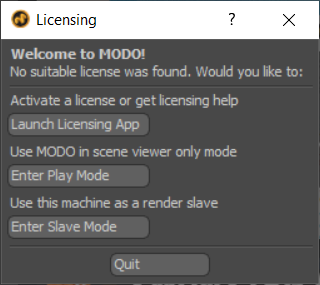
Launch Licensing App
Clicking this button opens the Licensing app where you can manage your licenses and run diagnostic tools.
For more information on how to license Modo, refer to Licensing Modo on Linux.
Running in Play Mode
Play mode places Modo in a special state where it acts as a scene viewer. In this state the interfaces are mostly disabled, but it allows you to load scenes and render and save them, both in Preview and using F9; opening the Render Display window.
One unique function of Play mode is its ability to detect scene changes and auto-reload the scene. What this means is any scene opened from over a network and previewed, when updated on another system, saves files to the scene file, reloads the scene on the networked system and updates the preview viewport. This allows the secondary system to act as a dedicated preview system without the need for a second license.
Running in Worker Mode
Worker mode is related to network rendering and places Modo in a state where other Modo installations can control its renderer. For information on how to set up Network Rendering, please reference the Network Rendering page.
Updates and Statistics
When Modo launches for the first time with a valid license, you are presented with a dialog, which enables you to set preferences to check for updates and to submit usage statistics.
Updates
Get the latest reminders to update Modo. You can have Modo automatically check for updates on every launch, daily or weekly. By default, this preference is set to Every Launch.
Usage Statistics
To help improve the quality of Modo, you can agree to submit usage data to the Modo Development team. These statistics are submitted anonymously and include details on the build number run, the system platform, the application active and idle times, and whether sessions exit successfully or not. In the event of a crash, the most recently executed commands are also submitted.
Note: Graphics card information is not submitted.
Tip: To reset your settings, open System > Preferences, expand Defaults > Application and reset the options for the following:
Automatically Check for Updates
Automatically Submit Usage Statistics
The following settings are available: Never, Every Launch, Daily, or Weekly.
Article: You can disable the Alert dialog in the Form Editor. For details on how to do this, see Q100345: How to disable all new Alert dialog boxes for the Modo 11 series onward.
Running in Safe Mode
In the unlikely event of a crash, you can run Modo in Safe Mode to help us determine what is causing the problem. When Modo runs in Safe Mode, it doesn't load any third-party plug-ins, kits, or user customizations and only runs using the contents of the Modo install directory. Safe Mode is primarily used for debugging purposes. When running in Safe Mode, a pristine configuration file is used.
Note: When exiting Safe Mode, your existing configuration file (modo_15.2.rc) is not overwritten.
A backup of configuration file is created at shutdown, when changes are saved. This backup file can be renamed to restore the previous state if configuration changes cause issues. When a corrupt configuration is detected, it is renamed, instead of deleted, which allows you to recover data from corrupted configuration file.
Save your configuration file and submit it to Support for debugging. Your configuration file is stored in the /home/<username>/.luxology directory.
To run in Safe Mode:
• Using the Terminal, navigate to the Modo application directory where you installed Modo, and enter:
./Modo10.2v2 -safemode -dbon:noconfig
If Modo successfully launches in Safe Mode, click File > Config Save to overwrite your existing configuration file that was causing Modo to crash.
Licensing Modo on Linux
The following licensing methods are available:
• Log-in Licenses - A license tied to your Foundry website account, available for either subscriptions or perpetual maintenance entitlements. They can be activated on up to 2 machines at once and deactivated if you need to use the entitlement elsewhere. Activating Modo installs a rolling temporary license which can be used offline for up to 37 days. The license is refreshed whenever Modo is connected to the internet.
The following video walks you through using Modo's log-in licensing tool.
Note: Log-in licenses for Modo plug-ins Power Translators and Power Sub-D to NURBS are added alongside your Modo log-in license entitlements. If you install one of these plug-ins when the device is already authorized, please go to Help > Modo Licensing > Advanced > Deauthorise this device, and then log-in again in order to display plug-in licenses. All of your entitlements are added together.
• Activation Keys - A code which can be used to generate a license after purchase. Activation Keys can be provided for node-locked, floating and log-in licenses. They can be activated from the application's Licensing dialog or using the Activate a Product Page: https://www.foundry.com/licensing/activate-product.
• Node Locked Licenses - A license locked to a specific machine. Node-locked licenses, sometimes called uncounted licenses, do not require a license server or other resources to run. The license is for a single machine, if you need to move the license you’ll have to submit a transfer request.
• Floating Licenses - A license locked to a machine that acts as a license server to enable any machine on the network to run an application. The license is installed on the server machine along with license server software. The license server software is installed with the Foundry Licensing Utility.
The number of machines that can run the application at the same time is limited by the number of floats in the license. Any machine can request a license, the server will issue a license as long as one is available. When the application exits it releases the license.
You can find more information about licensing Foundry products at learn.foundry.com/licensing
Note: If you are simply installing render nodes on a networked system, no license is required for Modo. Modo can also be run in Play mode to load scenes, navigate the viewport to look at them, and to render them (stills or animations). This allows you to render scenes on one system while continuing to work on another using your license. Play mode is available in the licensing dialog by clicking Enter Play Mode. For more information, see Running in Play Mode.
In all other instances, you need to have a license or a trial version of Modo.
To Install a Log-in License
To activate your license, follow these steps:
| 1. | Launch Modo using any of the methods described in Launching Modo on Linux. |
The Licensing dialog displays.

| 2. | Click Launch Licensing App. |
The following window appears.
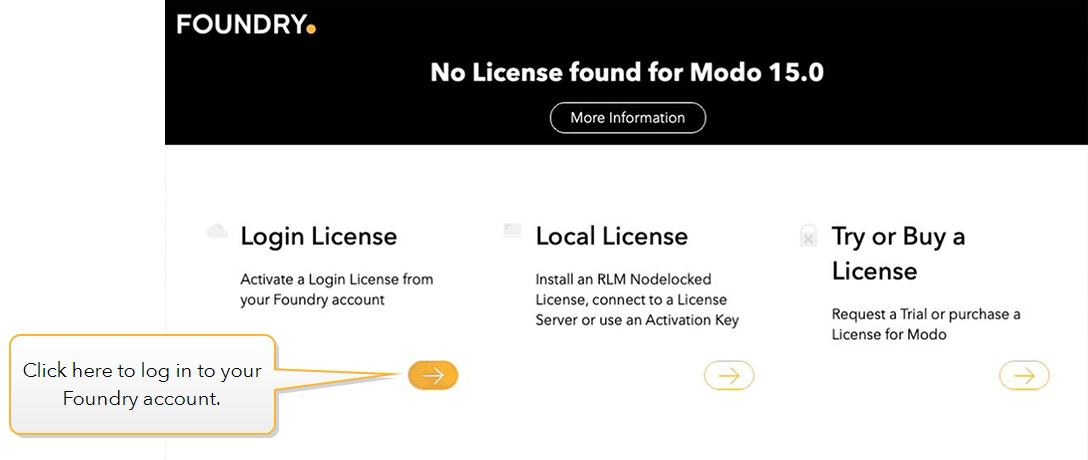
| 3. | Click the button for Login License and Sign In with your Foundry account email address and password. |
A license is created in the following directory: $HOME/.local/share/Foundry/Tokens or $XDG_DATA_HOME/Foundry/Tokens if the $XDG_DATA_HOME variable is set.
The license key looks something like this: c58edf7e-17ab-435b-8d8a-b3a9b347ab11.lic
| 4. | Select the license you want to install from the list and click Install. |
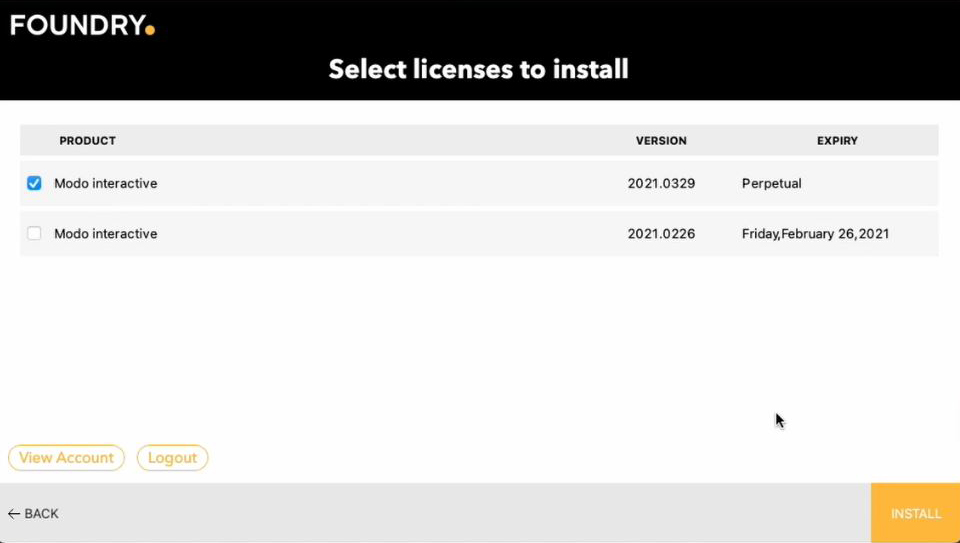
| 5. | Once the license is installed, click Done to close the Licensing App. |
You can now use Modo.
Note: A license is activated for a period of 38 days. Make sure that you connect to the internet once during the activation period to extend your access. You can check the activation period of your license in the Help > Modo Licensing menu.
| 6. | If you need to deactivate your license on the current machine, navigate to Help > Modo Licensing, click Manage Login Licenses. |
• Click on Logout to return all licenses and logout from the machine or;
• Select the license(s) you need to deactivate and click Return.
Obtaining Legacy Licenses
To obtain a legacy license, you'll need your machine's System ID (sometimes called Host ID or rlmhostid). Just so you know what a System ID number looks like, here’s an example: 000ea641d7a1.
Bear in mind that, for floating licenses, you'll need the System ID of the license server, not the machines on which you intend to run the application. There are a number of ways you can find out your machine's System ID:
• Download the Foundry License Utility (FLU) from https://www.foundry.com/licensing and run it. Click System ID to display it on screen.
When you know your System ID, you can request a license for Foundry products from Foundry's Sales Department at sales@foundry.com.
To Install a License from Disk
If you've copied a license to a known location on disk:
| 1. | Launch Modo using any of the methods described in Launching Modo on Linux. |
The Licensing dialog displays.

| 2. | Click Launch Licensing App and then click the button for Local License. |
| 3. | Click License File. |
The following window opens.
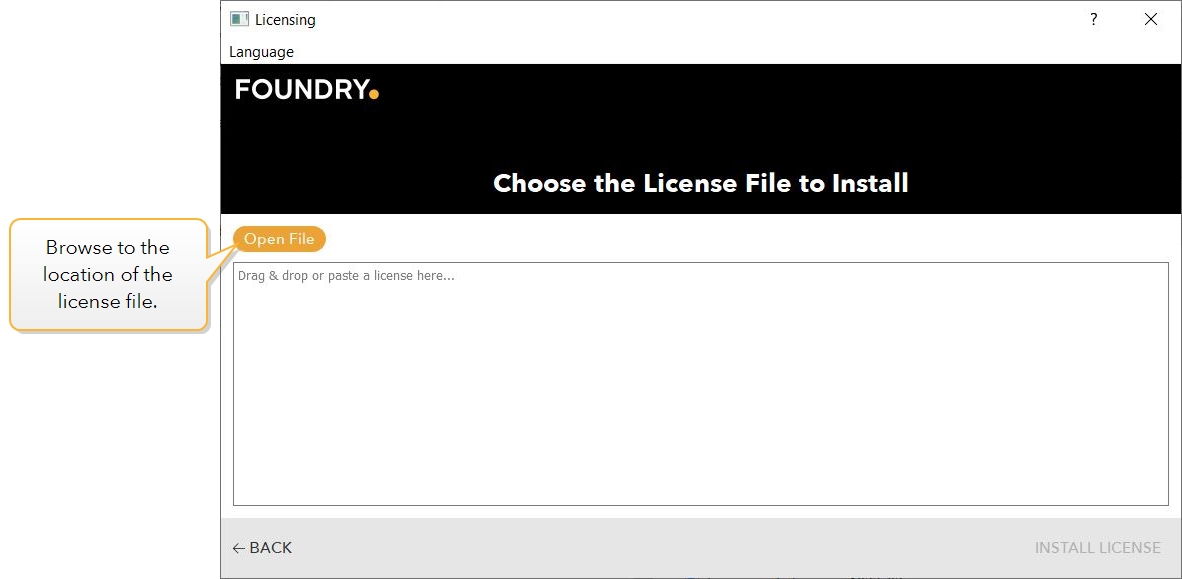
| 4. | Click Open File to locate the license file. |
| 5. | Click Open to install the license automatically in the correct directory. |
Once the license is validated, Modo displays a notification dialog.
To Install a License from a Text File
| 1. | Launch Modo using any of the methods described in Launching Modo on Linux. |
The Licensing dialog displays.

| 2. | Click Launch Licensing App and then click the button for Local License. |
| 3. | Click License File. |
The following window opens.

| 4. | Copy and paste the license text into the window and click Install license. |
The license is automatically installed on your machine in the correct directory.
To Install a Floating License
If you requested a floating license from Foundry, you receive your license key (foundry.lic) in an e-mail or internet download. You should also receive the Foundry License Utility (FLU) application to help you install the license key on the license server machine. The server manages licenses for the client machines on your network.
Note: The FLU is also available to download from https://www.foundry.com/licensing.
| 1. | Make sure you have saved both the license key (foundry.lic) and the FLU application in the same directory. |
| 2. | Run the FLU application. |
The license key automatically appears in the FLU window if the FLU and foundry.lic are in the same directory.
Tip: If they are not in the same directory, you can either copy and paste the contents of the license key or drag-and-drop the file into the FLU window.
| 3. | Click Install. |
This checks the license file and, provided that the license is valid, installs it into the correct directory.
| 4. | In order for the floating license to work, you will need to install the Foundry Licensing Tools (FLT) on the license server machine. |
For more information on how to install floating licenses, refer to the FLT User Guide, which you can download from our website https://www.foundry.com/licensing
| 5. | Once your license server is up and running, launch Modo on the client machine. |
The Licensing dialog displays.

| 6. | Click Launch Licensing App and then click the button for Local License. |
| 7. | Click Server and enter the server address in the field provided. The format for the server name is: <port>@<servername>, for example, 30001@red. |
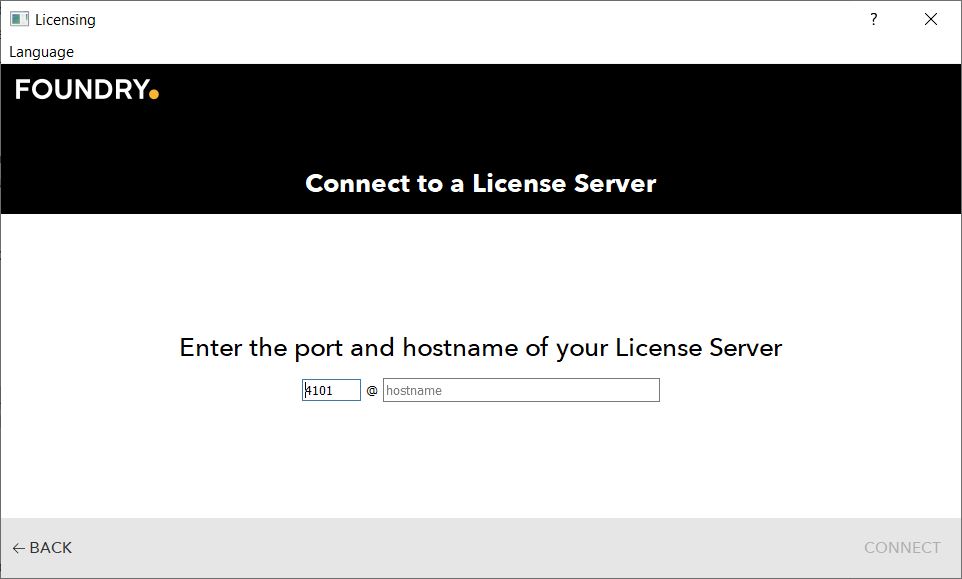
Note: You must perform these steps on each client machine that requires a license from the server.
Roaming for Floating Licenses
You can check out a roaming license from the pool of floating licenses available on a server and use it offline, on the system used to check it out, for a specified number of days, up to a maximum of 30 days. After the specified time the license expires and you have to connect to the server to renew or return it.
When you claim a license to use offline, the number of licenses available on the server decreases by one until you return the license.
To start roaming:
| 1. | Make sure you're connected to your license server. |
| 2. | From the application menu bar, click Help > Modo Licensing. |
This displays the Licensing App.

| 3. | Click Manage Roaming. |
| 4. | At the bottom of the dialog, enter the number of days for which you want to check the license out, then click Roam Licenses. |

Note: The value must be between 1 and 30.
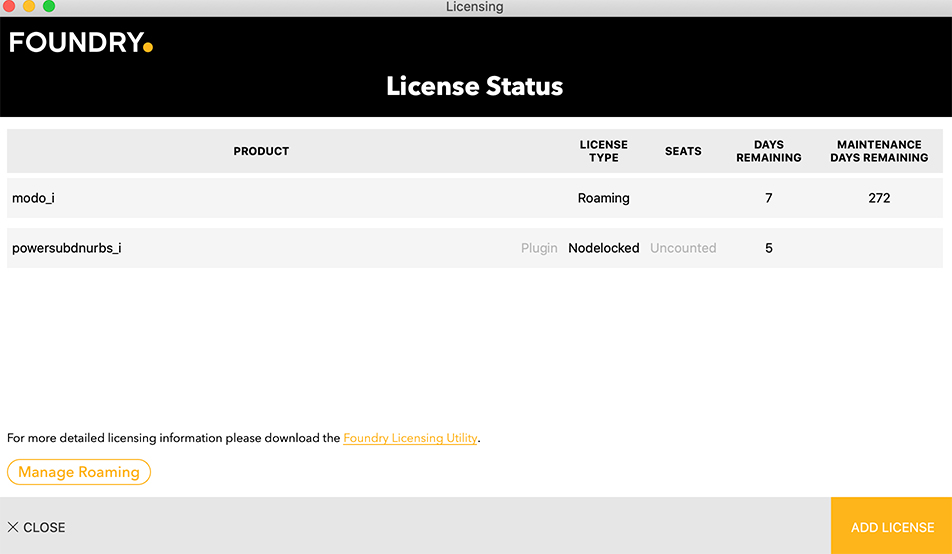
On the license status page, your license is now listed as Roaming.
You can now run Modo offline for the specified number of days.
To return a license:
| 1. | Make sure you're connected to the license server. |
| 2. | From the application menu bar, click Help > Modo Licensing. |
This displays the Licensing App.
| 3. | Click Manage Roaming. |
| 4. | Click Return Licenses. |

| 5. | Click Close. |
| 6. | Close and re-open Modo for the changes to take effect. |
Deactivating a Modo License
Login-based licensing allows you to deactivate your license from one machine and then activate it on another. This gives you the flexibility to easily use your Modo Subscription or Modo with Maintenance license on different machines when or if you need to.
You can deactivate your login-based license directly in Modo or through the Foundry website.
Deactivating a License in Modo
| 1. | Launch Modo and click Help > Modo Licensing in the main menu bar. |
The Licensing dialog displays the active license installed on the machine.
| 2. | Click Advanced and then Deauthorise this device to deactivate the license and remove it from the machine. |
| 3. | Quit Modo. |
Deactivating a License on Our Website
You can also deactivate the license from your activated machine through the My Account pages on our website. This is useful if you need to use your license at home but forgot to log out of Modo at work.
| 1. | Go to the Foundry My Account - Products page and login if prompted. |
For more information about Foundry user accounts, see Getting a Foundry User Account.
| 2. | Navigate to your Subscription or with Maintenance product and click View your entitlement. |
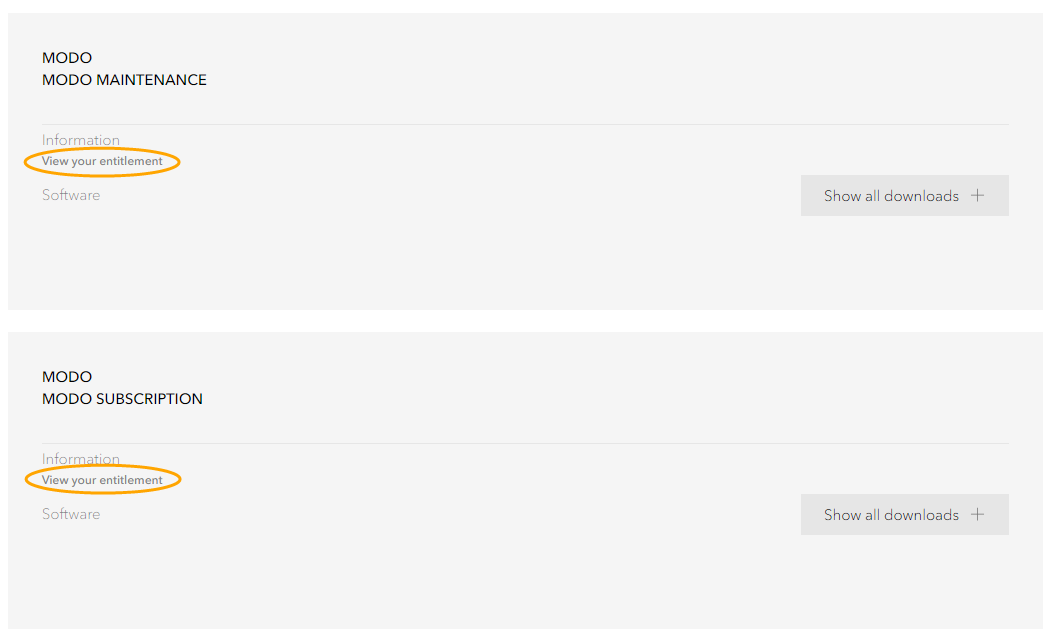
Tip: If you're having difficulty viewing the entitlement page log out of the website using this link, https://www.foundry.com/user/logout, and then log back in again.
| 3. | Click Modo to see the details of your subscription. |

| 4. | Click on the license key under the License currently activate by section. |
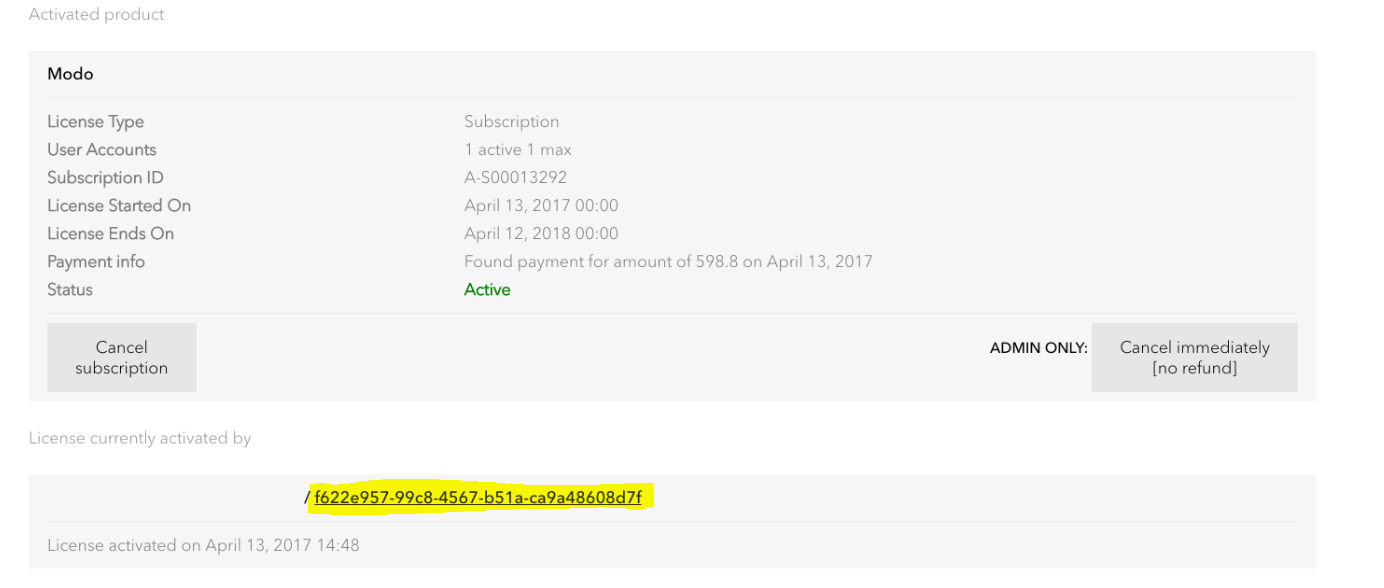
| 5. | In the Activated Products section, under modo_i, click Deactivate Entitlement to remove the Modo license from that machine. |
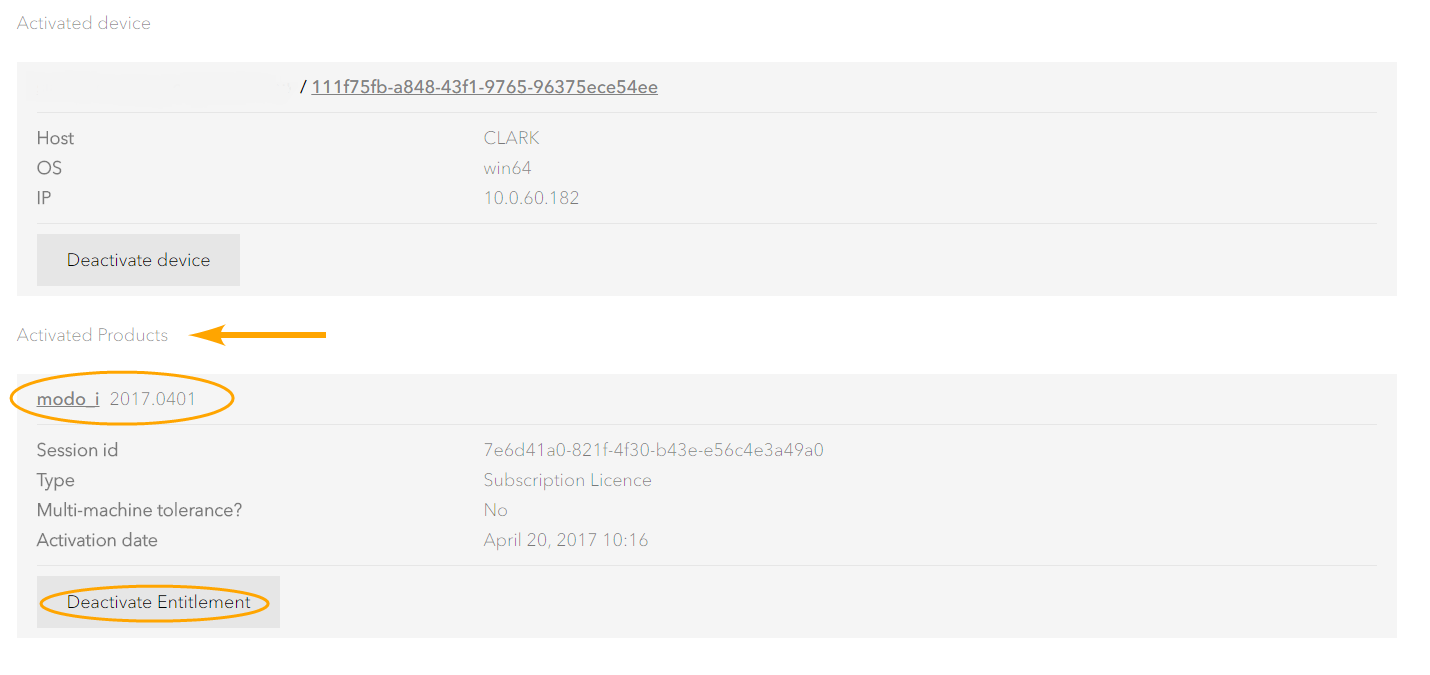
Warning: If you click on Deactivate device, all login-based licenses (including any Nuke Non-Commercial or Mari Non-Commercial) will be removed from the machine.
Tip: For an overview of the documentation and quick access to the main topics, go to Docs Home.
